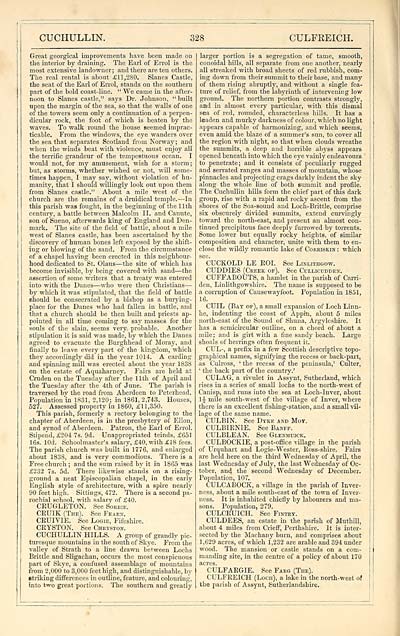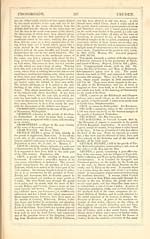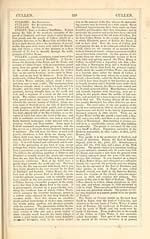Download files
Complete book:
Individual page:
Thumbnail gallery: Grid view | List view

CUCHULLIN.
328
CULFREICH.
Great georgical improvements have been made on
the interior by draining. The Earl of Errol is the
most extensive landowner ; and there are ten others.
The real rental is about £11,280. Slanes Castle,
the seat of the Earl of Errol, stands on the southern
part of the bold coast-line. " We came in the after-
noon to Slanes castle," says Dr. Johnson, " built
upon the margin of the sea, so that the walls of one
of the towers seem only a continuation of a perpen-
dicular rock, the foot of which is beaten by the
waves. To walk round the house seemed imprac-
ticable. From the windows, the eye wanders over
the sea that separates Scotland from Norway; and
when the winds beat with violence, must enjoy all
the terrific grandeur of the tempestuous ocean. I
would not, for my amusement, wish for a storm;
but, as storms, whether wished or not, will some-
times happen, I may say, without violation of hu-
manity, that I should willingly look out upon them
from Slanes castle." About a mile west of the
church are the remains of a druidical temple. — In
this parish was fought, in the beginning of the 11th
century, a battle between Malcolm II. and Canute,
son of Sueno, afterwards king of England and Den-
mark. The site of the field of battle, about a mile
west of Slanes castle, has been ascertained by the
discovery of human bones left exposed by the shift-
ing or blowing of the sand. From the circumstance
of a chapel having been erected in this neighbour-
hood dedicated to St. Olaus — the site of which has
become invisible, by being covered with sand — the
assertion of some writers that a treaty was entered
into with the Danes — who were then Christians —
by which it was stipulated, that the field of battle
should be consecrated by a bishop as a burying-
place for the Danes who had fallen in battle, and
that a church should be then built and priests ap-
pointed in all time coming to say masses for the
souls of the slain, seems very probable. Another
stipulation it is said was made, by which the Daues
agreed to evacuate the Burghhead of Moray, and
finally to leave every part of the kingdom, which
they accordingly did in the year 1014. A carding
and spinning mill was erected about the } r ear 1838
on the estate of Aquaharney. Fairs are held at
Cruden on the Tuesday after the 11th of April and
the Tuesday after the 4th of June. The parish is
traversed by the road from Aberdeen to Peterhead.
Population 'in 1831, 2,120; in 1861, 2,743. Houses,
527. Assessed property in 1860, £11,350.
This parish, formerly a rectory belonging to the
chapter of Aberdeen, is in the presbytery of Ellon,
and synod of Aberdeen. Patron, the Earl of Errol.
Stipend, £204 7s. 9d. Unappropriated teinds, £651
16s. lOd. Schoolmaster's salary, £40, with £18 fees.
The parish church was built in 1776, and enlarged
about 1838, and is very commodious. There is a
Free church ; and the sum raised by it in 1865 was
£232 7s. 5d. There likewise stands on a rising-
ground a neat Episcopalian chapel, in the early
English style of architecture, with a spire nearly
90 feet high. Sittings, 472. There is a second pa-
rochial school, with salary of £40.
CRUGLETON. See Soebie.
CEUIK (The). See Feap.n.
CRUIVIE. See Logie, Fifeshire.
CRYSTON. See Chkyston.
CUCHULLIN HILLS. A group of grandly pic-
turesque mountains in the south of Skye. From the
valley of Strath to a line drawn between Lochs
Brittle and Sligachan, occurs the most conspicuous
part of Skye, a confused assemblage of mountains
from 2,000 to 3,000 feet high, and distinguishable, by
striking differences in outline, feature, and colouring,
into two great portions. The southern and greatly
larger portion is a segregation of tame, smooth,
conoidal hills, all separate from one another, nearly
all streaked with broad sheets of red rubbish, com-
ing down from their summit to their base, and many
of them rising abruptly, and without a single fea-
ture of relief, from the labyrinth of intervening low
ground. The northern portion contrasts strongly,
and in almost every particular, with this dismal
sea of red, rounded, characterless hills. It has a
leaden and murky darkness of colour, which no light
appears capable of harmonizing, and which seems,
even amid the blaze of a summer's sun, to cover all
the region with night, so that when clouds wreathe
the summits, a deep and horrible abyss appears
opened beneath into which the eye vainly endeavours
to penetrate; and it consists of peculiarly rugged
and serrated ranges and masses of mountain, whose
pinnacles and projecting crags darkly indent the sky
along the whole line of both summit and profile.
The Cuchullin hills form the chief part of this dark
group, rise with a rapid and rocky ascent from the
shores of the Soa-sound and Loch-Brittle, comprise
six obscurely divided summits, extend curvingly
toward the north-east, and present an almost con-
tinued precipitous face deeply furrowed by torrents.
Some lower but equally rocky heights, of similar
composition and character, unite with them to en-
close the wildly romantic lake of C'orkisejn : which
see.
CUCKOLD LE ROI. See Linlithgow.
CUDDIES (Creek or). See Cullicudden.
CUFFABOUTS, a hamlet in the parish of Cani-
den, Linlithgowshire. The name is supposed to be
a corruption of Cause wayfoot. Population in 1851 ,
16.
CUIL (Bay of), a small expansion of Loch Linn-
he, indenting the coast of Appin, about 5 miles
north-east of the Sound of Shuna. Argyleshire. It
has a semicircular outline, on a chord of about a
mile; and is girt with a fine sandy beach. Large
shoals of herrings often frequent it.
CUL-, a prefix in a few Scottish descriptive topo-
graphical names, signifying the recess or back-part,
as Culross, ' the recess of the peninsula, 1 Culter,
' the back part of the country.'
CULAG, a rivulet in Assynt, Sutherland, which
rises in a series of small lochs to the north-west of
Canisp, and runs into the sea at Loch-Inver, about
li mile south-west of the village of Inver, where
there is an excellent fishing-station, and a small vil-
lage of the same name.
CULBIN. See Dyke and Moy.
CULBIRNIE. See Banff.
CULBLEAN. See Glenmuick.
CULBOCKIE, a post-office village in the parish
of Urquhart and Logie- Wester, Ross-shire. Fairs
are held here on the third Wednesday of April, the
last Wednesday of July, the last Wednesday of Oc-
tober, and the second Wednesday of December.
Population, 107.
CULCABOCK, a village in the parish of Inver-
ness, about a mile south-east of the town of Inver-
ness. It is inhabited chiefly by labourers and ma-
sons. Population, 279.
CULCRUICH. See Fintry.
CULDEES, an estate in the parish of Muthill,
about 4 miles from Crieff, Perthshire. It is inter-
sected by the Machany burn, and comprises about
1,629 acres, of which 1,232 are arable and 394 under
wood. The mansion or castle stands on a com-
manding site, in the centre of a policy of about 170
acres.
CULFARGIE. See Fakg (The).
CULFREICH (Loch), a lake in the north-west of
the parish of Assynt, Sutherlandshire.
328
CULFREICH.
Great georgical improvements have been made on
the interior by draining. The Earl of Errol is the
most extensive landowner ; and there are ten others.
The real rental is about £11,280. Slanes Castle,
the seat of the Earl of Errol, stands on the southern
part of the bold coast-line. " We came in the after-
noon to Slanes castle," says Dr. Johnson, " built
upon the margin of the sea, so that the walls of one
of the towers seem only a continuation of a perpen-
dicular rock, the foot of which is beaten by the
waves. To walk round the house seemed imprac-
ticable. From the windows, the eye wanders over
the sea that separates Scotland from Norway; and
when the winds beat with violence, must enjoy all
the terrific grandeur of the tempestuous ocean. I
would not, for my amusement, wish for a storm;
but, as storms, whether wished or not, will some-
times happen, I may say, without violation of hu-
manity, that I should willingly look out upon them
from Slanes castle." About a mile west of the
church are the remains of a druidical temple. — In
this parish was fought, in the beginning of the 11th
century, a battle between Malcolm II. and Canute,
son of Sueno, afterwards king of England and Den-
mark. The site of the field of battle, about a mile
west of Slanes castle, has been ascertained by the
discovery of human bones left exposed by the shift-
ing or blowing of the sand. From the circumstance
of a chapel having been erected in this neighbour-
hood dedicated to St. Olaus — the site of which has
become invisible, by being covered with sand — the
assertion of some writers that a treaty was entered
into with the Danes — who were then Christians —
by which it was stipulated, that the field of battle
should be consecrated by a bishop as a burying-
place for the Danes who had fallen in battle, and
that a church should be then built and priests ap-
pointed in all time coming to say masses for the
souls of the slain, seems very probable. Another
stipulation it is said was made, by which the Daues
agreed to evacuate the Burghhead of Moray, and
finally to leave every part of the kingdom, which
they accordingly did in the year 1014. A carding
and spinning mill was erected about the } r ear 1838
on the estate of Aquaharney. Fairs are held at
Cruden on the Tuesday after the 11th of April and
the Tuesday after the 4th of June. The parish is
traversed by the road from Aberdeen to Peterhead.
Population 'in 1831, 2,120; in 1861, 2,743. Houses,
527. Assessed property in 1860, £11,350.
This parish, formerly a rectory belonging to the
chapter of Aberdeen, is in the presbytery of Ellon,
and synod of Aberdeen. Patron, the Earl of Errol.
Stipend, £204 7s. 9d. Unappropriated teinds, £651
16s. lOd. Schoolmaster's salary, £40, with £18 fees.
The parish church was built in 1776, and enlarged
about 1838, and is very commodious. There is a
Free church ; and the sum raised by it in 1865 was
£232 7s. 5d. There likewise stands on a rising-
ground a neat Episcopalian chapel, in the early
English style of architecture, with a spire nearly
90 feet high. Sittings, 472. There is a second pa-
rochial school, with salary of £40.
CRUGLETON. See Soebie.
CEUIK (The). See Feap.n.
CRUIVIE. See Logie, Fifeshire.
CRYSTON. See Chkyston.
CUCHULLIN HILLS. A group of grandly pic-
turesque mountains in the south of Skye. From the
valley of Strath to a line drawn between Lochs
Brittle and Sligachan, occurs the most conspicuous
part of Skye, a confused assemblage of mountains
from 2,000 to 3,000 feet high, and distinguishable, by
striking differences in outline, feature, and colouring,
into two great portions. The southern and greatly
larger portion is a segregation of tame, smooth,
conoidal hills, all separate from one another, nearly
all streaked with broad sheets of red rubbish, com-
ing down from their summit to their base, and many
of them rising abruptly, and without a single fea-
ture of relief, from the labyrinth of intervening low
ground. The northern portion contrasts strongly,
and in almost every particular, with this dismal
sea of red, rounded, characterless hills. It has a
leaden and murky darkness of colour, which no light
appears capable of harmonizing, and which seems,
even amid the blaze of a summer's sun, to cover all
the region with night, so that when clouds wreathe
the summits, a deep and horrible abyss appears
opened beneath into which the eye vainly endeavours
to penetrate; and it consists of peculiarly rugged
and serrated ranges and masses of mountain, whose
pinnacles and projecting crags darkly indent the sky
along the whole line of both summit and profile.
The Cuchullin hills form the chief part of this dark
group, rise with a rapid and rocky ascent from the
shores of the Soa-sound and Loch-Brittle, comprise
six obscurely divided summits, extend curvingly
toward the north-east, and present an almost con-
tinued precipitous face deeply furrowed by torrents.
Some lower but equally rocky heights, of similar
composition and character, unite with them to en-
close the wildly romantic lake of C'orkisejn : which
see.
CUCKOLD LE ROI. See Linlithgow.
CUDDIES (Creek or). See Cullicudden.
CUFFABOUTS, a hamlet in the parish of Cani-
den, Linlithgowshire. The name is supposed to be
a corruption of Cause wayfoot. Population in 1851 ,
16.
CUIL (Bay of), a small expansion of Loch Linn-
he, indenting the coast of Appin, about 5 miles
north-east of the Sound of Shuna. Argyleshire. It
has a semicircular outline, on a chord of about a
mile; and is girt with a fine sandy beach. Large
shoals of herrings often frequent it.
CUL-, a prefix in a few Scottish descriptive topo-
graphical names, signifying the recess or back-part,
as Culross, ' the recess of the peninsula, 1 Culter,
' the back part of the country.'
CULAG, a rivulet in Assynt, Sutherland, which
rises in a series of small lochs to the north-west of
Canisp, and runs into the sea at Loch-Inver, about
li mile south-west of the village of Inver, where
there is an excellent fishing-station, and a small vil-
lage of the same name.
CULBIN. See Dyke and Moy.
CULBIRNIE. See Banff.
CULBLEAN. See Glenmuick.
CULBOCKIE, a post-office village in the parish
of Urquhart and Logie- Wester, Ross-shire. Fairs
are held here on the third Wednesday of April, the
last Wednesday of July, the last Wednesday of Oc-
tober, and the second Wednesday of December.
Population, 107.
CULCABOCK, a village in the parish of Inver-
ness, about a mile south-east of the town of Inver-
ness. It is inhabited chiefly by labourers and ma-
sons. Population, 279.
CULCRUICH. See Fintry.
CULDEES, an estate in the parish of Muthill,
about 4 miles from Crieff, Perthshire. It is inter-
sected by the Machany burn, and comprises about
1,629 acres, of which 1,232 are arable and 394 under
wood. The mansion or castle stands on a com-
manding site, in the centre of a policy of about 170
acres.
CULFARGIE. See Fakg (The).
CULFREICH (Loch), a lake in the north-west of
the parish of Assynt, Sutherlandshire.
Set display mode to: Large image | Transcription
Images and transcriptions on this page, including medium image downloads, may be used under the Creative Commons Attribution 4.0 International Licence unless otherwise stated. ![]()
| Gazetteers of Scotland, 1803-1901 > Imperial gazeteer of Scotland, or, Dictionary of Scottish topography > Volume 1 > (438) Page 328 |
|---|
| Permanent URL | https://digital.nls.uk/97464386 |
|---|
| Description | Volume I: Aan-Gordon. |
|---|---|
| Attribution and copyright: |
|

